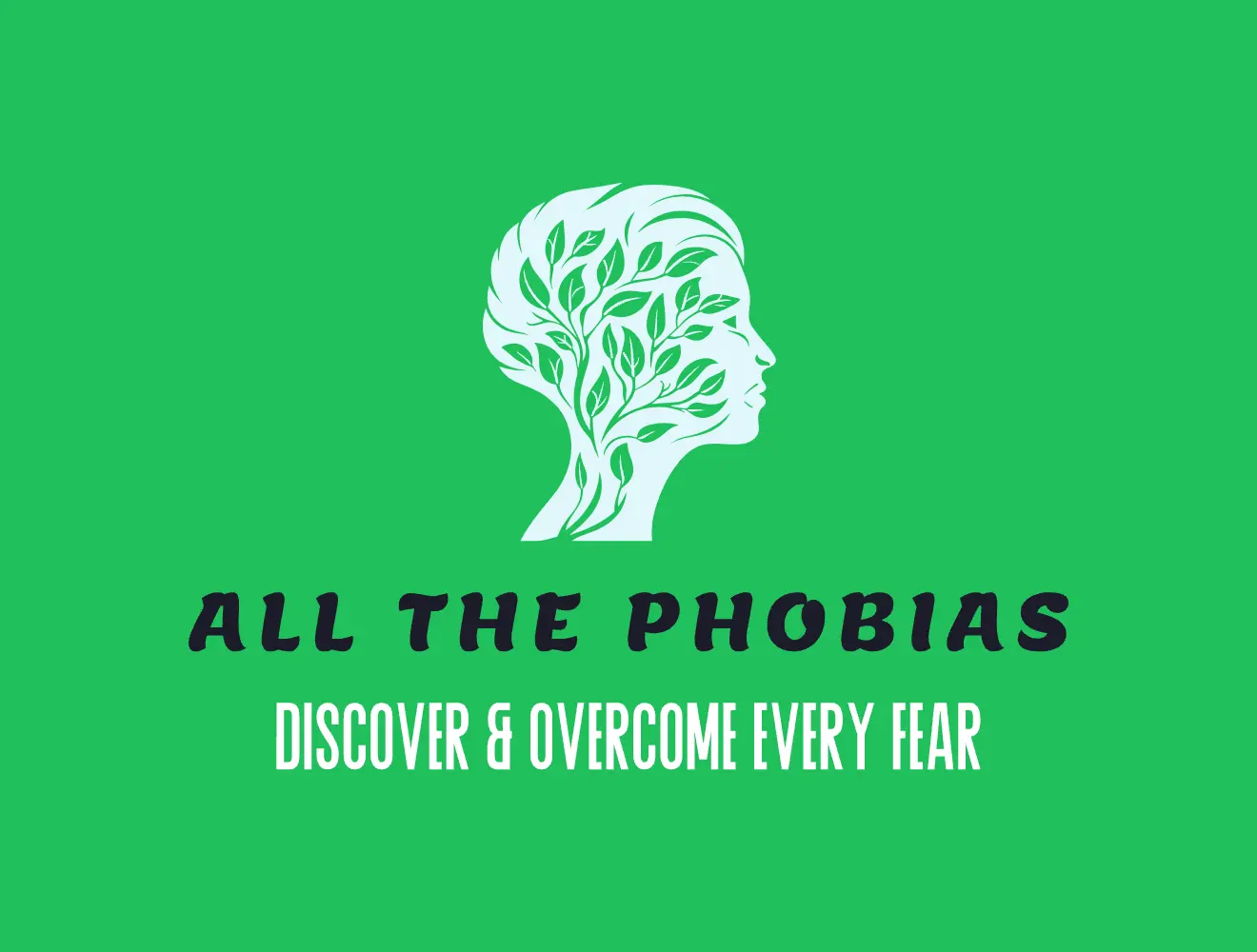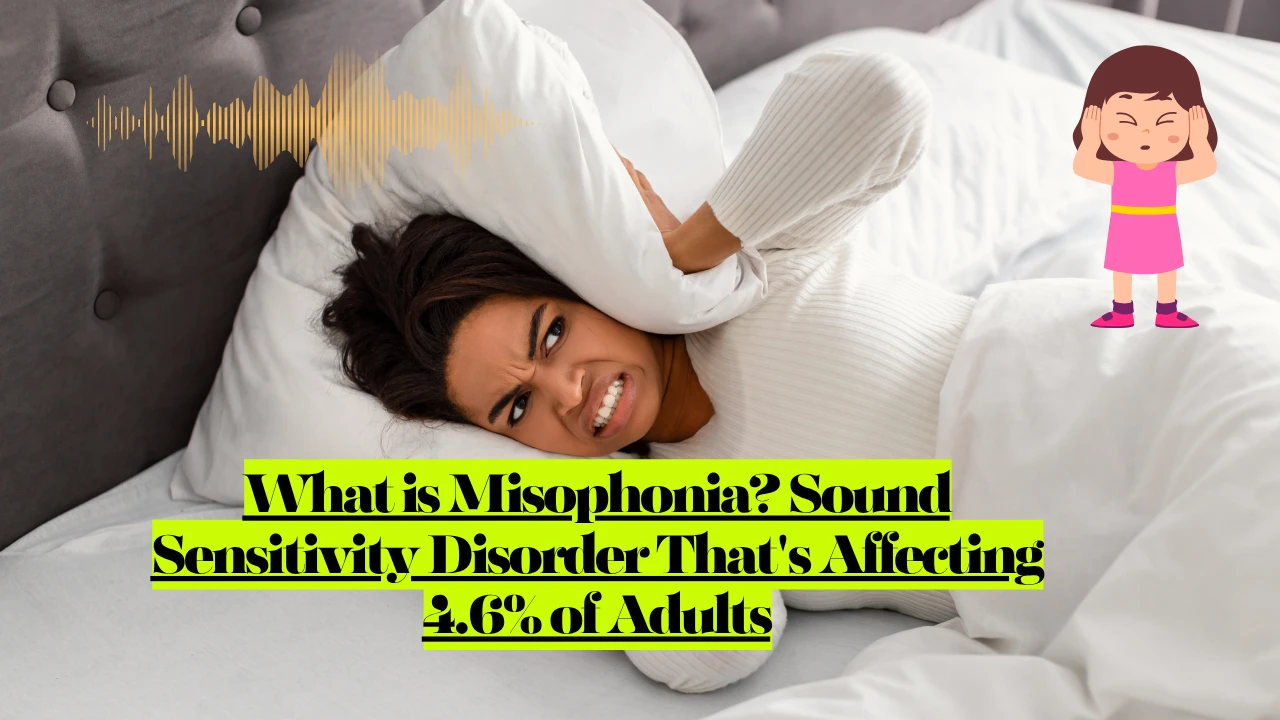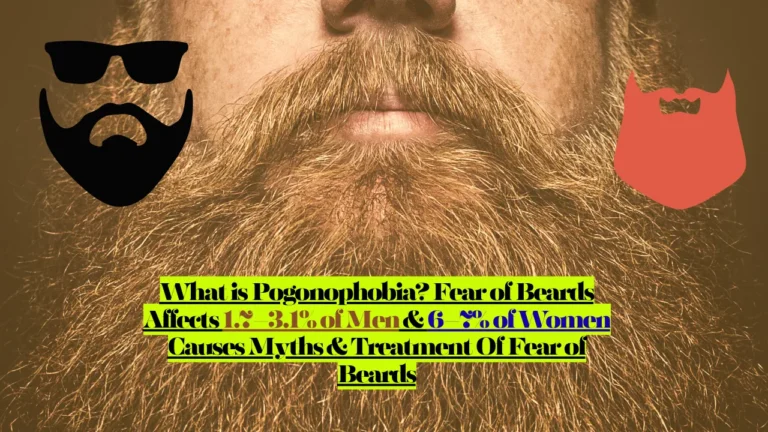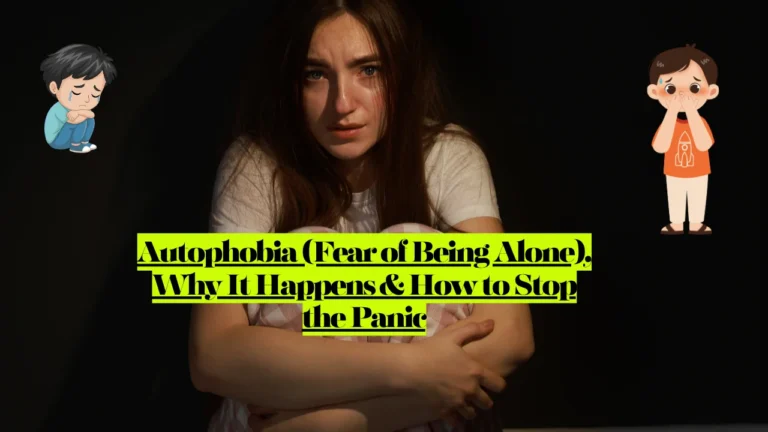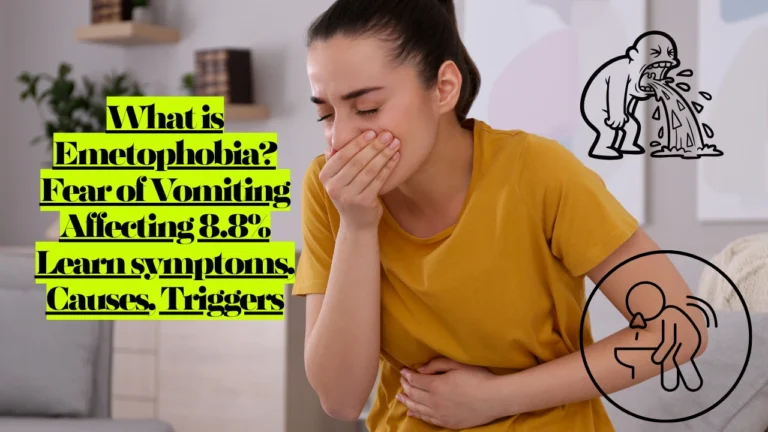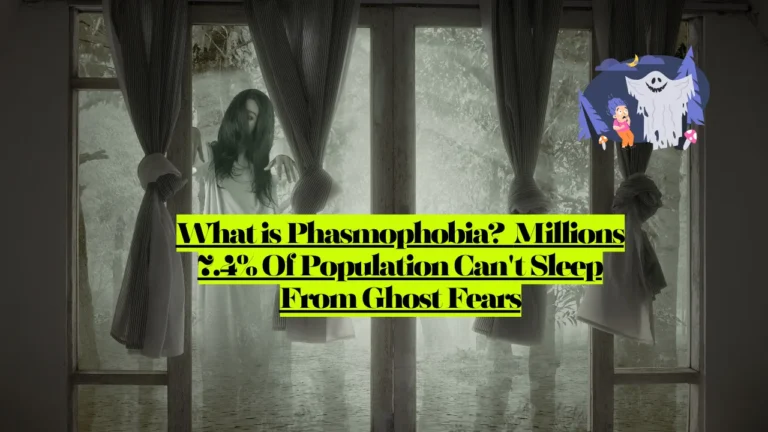Misophonia (or selective sound sensitivity syndrome) is a disorder of decreased tolerance to specific sounds or their associated stimuli, or cues. If you’re dealing with overwhelming fury when hearing chewing, breathing, or clicking sounds that disrupts your daily life, you’re likely experiencing this neurological condition.
Here’s what you need to know right away:
- 4.6% of U.S. adults report clinical levels of misophonia, while 78.5% experience sensitivity to misophonia sounds
- Close to 20% of the population experiences some level of misophonia, with 6% showing significant functional impairment
- 48% of patients improved after eight sessions of CBT, with symptoms improving by 4.5 points on clinical scales
- You can learn to manage this condition with evidence-based treatment approaches
At AllThePhobias.com, we’ve compiled the most current research and clinical insights to help you understand and address Misophonia. Based on analysis of leading medical sources including Harvard Health, Cleveland Clinic, and peer-reviewed research, this guide provides everything you need to know.
Do You Have Misophonia? Key Signs to Look For
Physical Symptoms When Hearing Trigger Sounds:
- Fight-or-flight response that triggers anger and a desire to escape
- Immediate muscle tension and increased heart rate
- Sweating, trembling, or temperature changes
- Clenched jaw, fists, or overall body rigidity
- Nausea or stomach discomfort
- Urge to flee or physically stop the sound
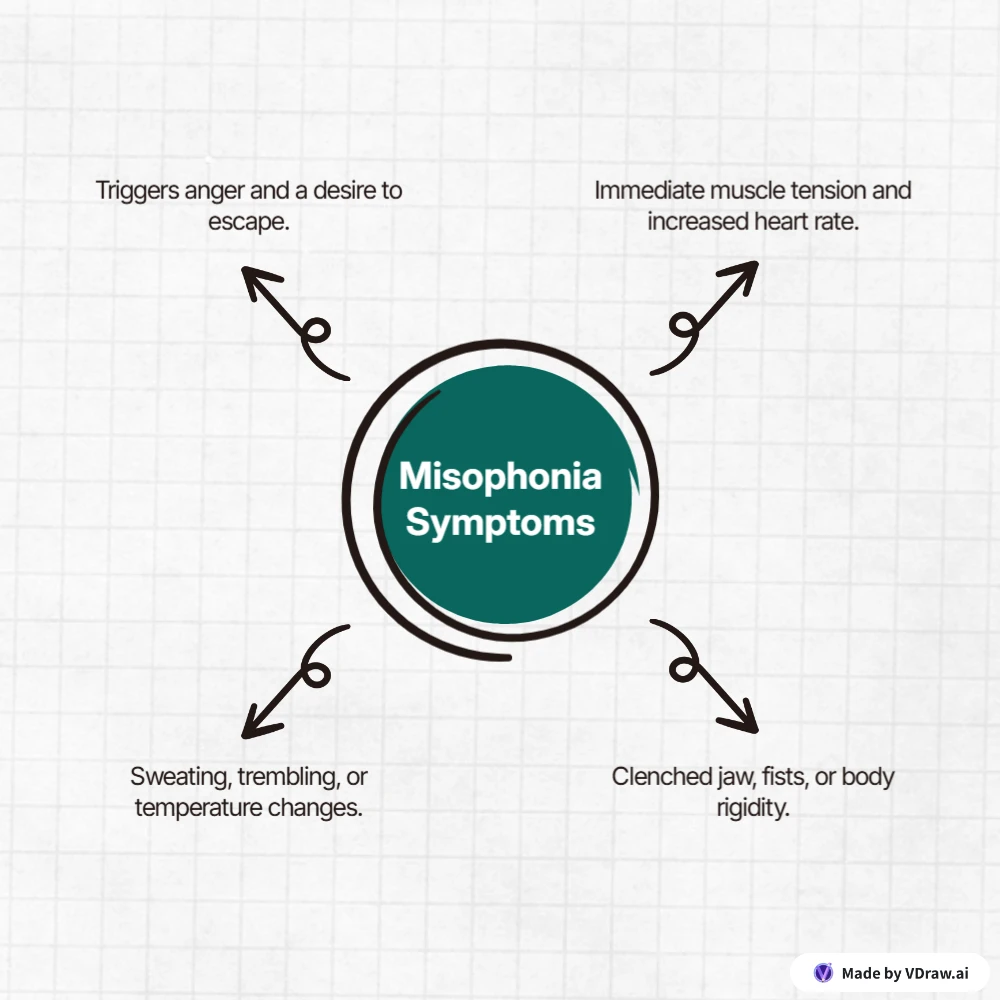
Emotional & Mental Responses:
- Intense rage and disgust provoked by hearing specific human sounds
- Feelings disproportionate to the actual sound volume
- Disgust or revulsion toward the sound maker
- Feeling trapped when unable to escape triggers
- Immediate emotional flooding that’s difficult to control
The severity ranges from mild discomfort you can manage to panic-level reactions that completely disrupt functioning.
Behavioral Changes:
- Social isolation due to avoidance of triggering situations
- Using headphones or earplugs constantly
- Leaving situations when trigger sounds occur
- Planning daily activities around avoiding triggers
- Avoidance behaviors that adversely affect the ability to achieve life goals and enjoy social situations
When these reactions persist and significantly impact work, relationships, or daily activities, professional evaluation is recommended.
Related Phobia: What is Koumpounophobia? Hidden Fear of Buttons Affecting 1 in 75,000 People
Understanding Misophonia: The Complete Analysis
What Causes This Sound Sensitivity?
The Science Behind It: Research shows misophonia is associated with altered brain activity in the auditory cortex and salience network. When you hear trigger sounds, abnormal neural pathways create immediate emotional responses bypassing normal sound processing.
Why Some People Develop It: Misophonia is characterized by strong negative emotions of anger and anxiety in response to certain everyday sounds, such as those generated by other people eating, drinking, and breathing. The condition involves both genetic predisposition and environmental factors.
Development Patterns:
- Learned responses: Classical conditioning where neutral sounds become associated with negative emotions
- Neurological basis: Recent research suggests a motor basis for misophonia involving mirror neuron systems
- Onset timing: Often emerges during childhood or adolescence
- Adult development: Can develop during high-stress periods or life transitions
Risk Factors:
- Often associated with Autism, but can affect anyone regardless of their neurological profile
- Family history of anxiety or sensory processing issues
- High sensitivity personality traits
- Co-occurring conditions like ADHD or OCD
- Environmental stress during development
How It Differs From Normal Sound Annoyance:
Normal sound irritation differs from misophonia, which triggers unusually strong emotions, body changes, and reactive behaviors. Clinical misophonia involves:
- Immediate, intense emotional reactions within seconds
- Physical fight-or-flight activation
- Inability to “tune out” specific sounds
- Reactions persisting despite logical understanding
- Significant daily life impairment
Myths vs. Facts About Misophonia
Myth #1: “Just ignore the sounds and you’ll get over it” Fact: Misophonia involves altered brain activity in the auditory cortex and salience network. You cannot “will away” a neurological response any more than you can ignore physical pain.
Myth #2: “You’re just being controlling or attention-seeking” Fact: Research shows immediate fight-or-flight activation within seconds of hearing triggers. This is an involuntary physiological response, not a behavioral choice.
Myth #3: “Everyone hates chewing sounds—you’re not special” Fact: Normal annoyance differs from clinical misophonia. 4.6% experience clinical-level symptoms requiring treatment, while general annoyance doesn’t cause panic attacks or life impairment.
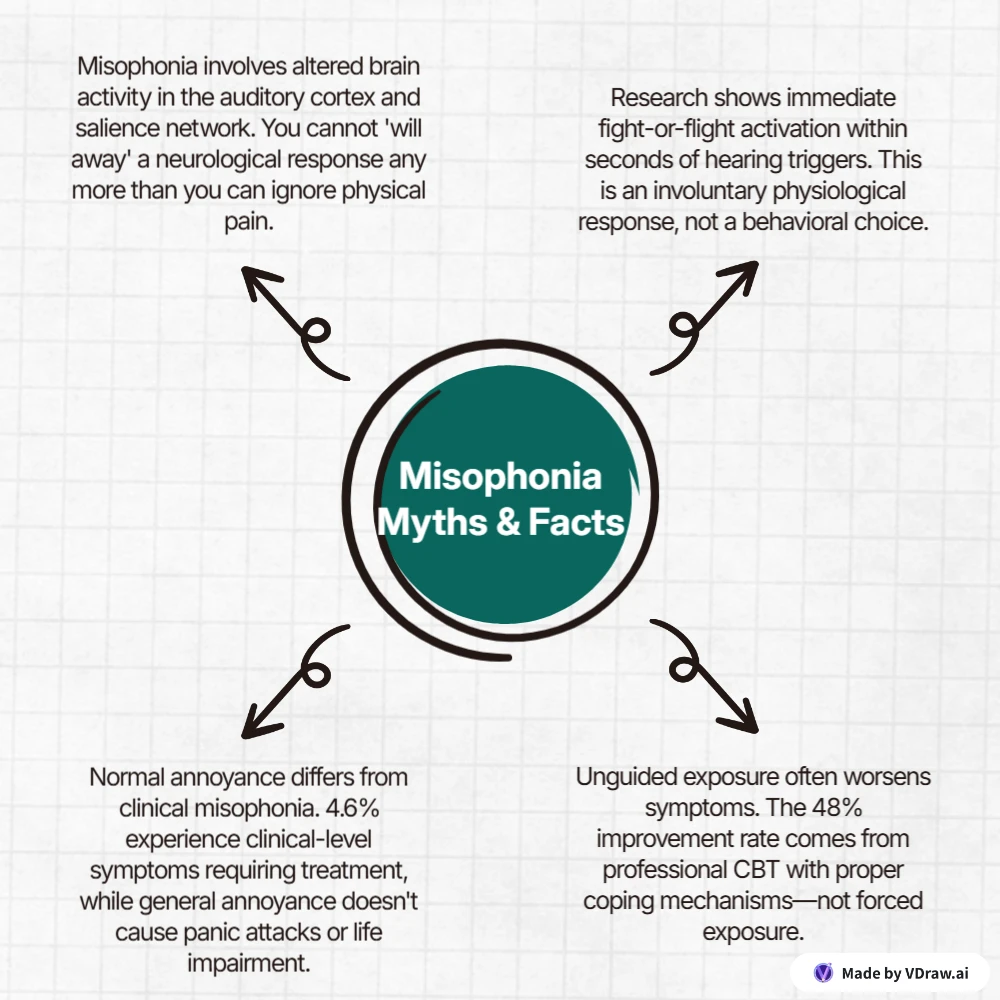
Myth #4: “Exposure will desensitize you automatically” Fact: Unguided exposure often worsens symptoms. The 48% improvement rate comes from professional CBT with proper coping mechanisms—not forced exposure.
Myth #5: “It’s just part of anxiety or OCD” Fact: While misophonia can co-occur with anxiety disorders, it’s a distinct condition with unique brain patterns and requires specialized treatment approaches.
Myth #6: “There’s no real treatment available” Fact: Clinical trials show 48% of patients improved after eight CBT sessions, with symptoms decreasing by 4.5 points on clinical scales.
Comprehensive Misophonia Triggers & Situations
Primary Trigger Categories:
Eating and Mouth Sounds (Most Common):
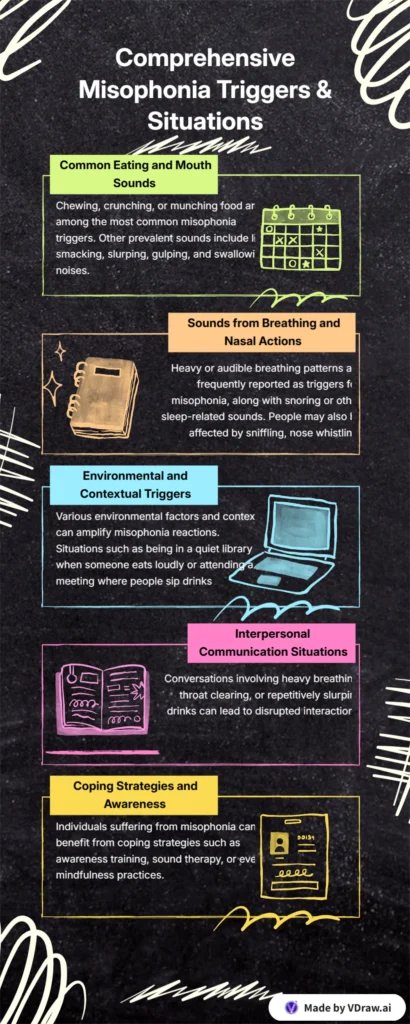
- Chewing, crunching, or munching food
- Lip smacking, slurping, or gulping
- Swallowing sounds or throat clearing
- Gum chewing or bubble popping
- Teeth grinding or clicking
- Coughing or throat sounds
Breathing and Nasal Sounds:
- Heavy or audible breathing patterns
- Snoring or sleep-related sounds
- Sniffling or nose whistling
- Repetitive sighing
- Congested breathing sounds
Repetitive Environmental Sounds:
- Pen clicking, tapping, or drumming
- Foot bouncing or finger drumming
- Keyboard typing (especially loud)
- Paper rustling or page turning
- Clock ticking or mechanical sounds
Modern Digital Triggers:
- ASMR video content (paradoxically triggering)
- Video conference eating or typing sounds
- Social media videos with trigger audio
- Gaming notification sounds
- Streaming content without audio warnings
ASMR Content (Paradoxically Triggering): ASMR (Autonomous Sensory Meridian Response) videos are designed to create relaxing tingles through soft sounds—whispering, tapping, crinkling. However, these exact sounds (especially eating, mouth sounds, and repetitive tapping) are common misophonia triggers. What helps others relax can cause immediate rage responses in misophonia sufferers. Many social media platforms lack trigger warnings on ASMR content, making accidental exposure common.
Severity and Individual Differences:
33.3% report sensitivity to at least one specific misophonic sound, with 21.3% experiencing subthreshold symptoms. Individual reactions vary from single-trigger sensitivity to multiple sound categories, with intensity influenced by stress, fatigue, and relationship to the sound source.
Real-World Impact & Life Challenges
Jennifer, a project manager, discovered her misophonia affected her career advancement when she couldn’t participate in working lunches or conference room meetings during snack times. After implementing professional coping strategies and workplace accommodations, she successfully navigated her triggers while maintaining professional relationships.
Common Life Areas Affected:
Work and Career Impact:
- Difficulties in personal relationships, work environments, and social interactions due to strong reactions to triggers
- Reduced productivity in open office environments
- Missing important meetings or networking events
- Limited career options in certain fields
- Workplace relationship strain and isolation
Relationships and Social Life:
- Family meal conflicts and dinner avoidance
- Romantic relationship challenges and communication issues
- Social gathering limitations and party avoidance
- Guilt and shame over reactions toward loved ones
- Isolation leading to depression and anxiety
Personal and Educational Activities:
- Movie theaters, concerts, and entertainment venue avoidance
- Gym, fitness classes, and group activity limitations
- Travel restrictions (planes, hotels, restaurants)
- Educational setting challenges and learning disruption
- Shopping and public transportation difficulties
Treatment & Recovery Options: Proven Ways to Overcome Misophonia
Professional Treatment (Most Effective):
Cognitive Behavioral Therapy (CBT): In clinical trials, 48% of patients improved after eight sessions of CBT, with misophonia symptoms improving by 4.5 points on the Amsterdam Misophonia Scale. Research shows both short-term and long-term efficacy, with CBT being effective in approximately half of patients.
How CBT Works: You learn to identify and modify thought patterns that intensify reactions to trigger sounds, developing healthier cognitive and behavioral responses.
Treatment Process: Typically 8-16 weekly sessions focusing on cognitive restructuring, exposure planning, and coping skill development with trained therapists.
Exposure Therapy Approaches: While there are no established evidence-based treatments yet, exposure therapy concepts show promise under empirical consideration. Professional-guided exposure involves gradual, controlled introduction of trigger sounds combined with relaxation techniques.
Other Professional Options:
- Tinnitus Retraining Therapy (TRT): Sound therapy combined with counseling approaches
- EMDR: Effective when misophonia developed following traumatic experiences
- Medication Support: Anti-anxiety medications for severe symptoms (when clinically appropriate)
- Combined Treatment: Systematic reviews show various treatment approaches under investigation for efficacy
Self-Help Management Strategies:
Immediate Coping Techniques:
- 4-7-8 breathing: Inhale 4, hold 7, exhale 8 counts
- Box breathing: 4-count inhale, hold, exhale, hold pattern
- Progressive muscle relaxation targeting tension areas
- 5-4-3-2-1 grounding: 5 see, 4 touch, 3 hear, 2 smell, 1 taste
Daily Management Tools:
- Noise-canceling headphones for prevention (not complete avoidance)
- White noise or nature sound apps during vulnerable times
- Mindfulness meditation and present-moment awareness
- Regular exercise to manage overall stress and sensitivity
- Consistent sleep schedule to reduce trigger reactivity
Environmental Modifications:
- Creating quiet zones in home and work spaces
- Strategic seating arrangements in restaurants and meetings
- Communication with family and friends about accommodation needs
- Building sound-safe retreat spaces for recovery
When to Seek Professional Help:
- When the condition often goes undiagnosed, leaving individuals struggling to cope with extreme sensitivity
- Reactions interfere with work, school, or relationships
- Avoidance behaviors limit important life activities
- Depression or anxiety develop from isolation
- Family relationships suffer significantly
- Self-help strategies provide insufficient relief
Support & Your Path Forward
Finding Qualified Professional Help:
Types of Specialists to Seek:
- Psychologists specializing in anxiety and sensory disorders
- Licensed therapists trained in CBT and exposure therapy
- Audiologists with misophonia treatment experience
- Psychiatrists familiar with sensory processing conditions
Essential Questions for Potential Therapists:
- How many misophonia patients have you treated successfully?
- What specific treatment protocols do you use?
- What’s your typical treatment timeline and expected outcomes?
- Do you offer both individual and family therapy options?
- How do you measure treatment progress and success?
Insurance and Treatment Access: Most insurance plans cover anxiety disorder treatment, which often includes misophonia therapy. Verify coverage and ask about sliding-scale fees or payment plans for specialized treatment providers.
Building Your Support Network:
How Family and Friends Can Help:
- Learn about misophonia as a neurological condition, not a choice
- Make reasonable environmental accommodations when possible
- Avoid intentionally making trigger sounds or dismissing reactions
- Support treatment goals and coping strategy practice
- Maintain patience during difficult trigger exposure moments
Community Resources:
- Misophonia support groups and online communities
- Educational resources from reputable organizations
- Family therapy to improve household communication
- Workplace accommodation guidance and advocacy
Moving Forward Successfully:
Research consistently shows CBT effectiveness in approximately half of patients, with significant symptom improvement possible. Recovery is a gradual process requiring professional guidance, family support, and consistent coping strategy practice. At AllThePhobias.com, we connect you with evidence-based resources for your treatment journey.
Immediate Coping Strategies & Resources
Emergency Management Techniques (Use Right Now):
4-7-8 Breathing Protocol:
- Exhale completely through your mouth making a “whoosh” sound
- Close mouth, inhale quietly through nose for 4 counts
- Hold breath for 7 counts
- Exhale through mouth for 8 counts making “whoosh” sound
- Repeat cycle 3-4 times maximum
5-4-3-2-1 Grounding Exercise:
- 5 things you can see: Notice colors, shapes, textures around you
- 4 things you can physically touch: Chair, table, clothing, phone
- 3 things you can hear: (Besides triggers) – traffic, voices, air conditioning
- 2 things you can smell: Coffee, soap, fresh air, cleaning products
- 1 thing you can taste: Gum, coffee, or focus on current mouth sensations
Progressive Muscle Relaxation: Start with toes, tense for 5 seconds, then release. Work systematically through calves, thighs, abdomen, arms, shoulders, face. Focus on the contrast between tension and relaxation.
Safe Space Visualization: Create detailed mental imagery of your most peaceful location. Include all sensory details: sounds, smells, textures, temperatures, and visual elements that promote calm feelings.
Daily Management and Prevention:
Mindfulness Integration:
- Daily meditation apps: Headspace, Calm, Insight Timer
- Body scan exercises during non-triggered times
- Mindful breathing practice 5-10 minutes daily
- Present-moment awareness exercises and grounding
Environmental Control Strategies:
- High-quality noise-canceling headphones (not for complete avoidance)
- White noise machines or apps for background masking
- Strategic positioning in restaurants (away from kitchen, families with children)
- Communication cards explaining accommodation needs
Stress Management Foundation:
- Regular exercise routine to reduce overall reactivity
- Consistent sleep schedule (7-9 hours nightly)
- Balanced nutrition avoiding excess caffeine
- Social connection maintenance despite trigger challenges
Crisis Support and Professional Resources:
Immediate Crisis Support:
- National Suicide Prevention Lifeline: 988 (24/7 crisis support)
- Crisis Text Line: Text HOME to 741741 (24/7 text-based support)
- National Anxiety Hotline: 1-800-950-6264
Specialized Misophonia Resources:
- Misophonia Research Fund: Educational materials and research updates
- International Misophonia Research Network: Clinical trial information
- Misophonia Association: Support groups and advocacy resources
- Duke University Misophonia Program: Treatment provider directory
Mobile Apps for Daily Management:
- Calm: Anxiety management and sleep support
- Headspace: Guided meditation and mindfulness training
- MyNoise: Customizable background sounds and masking
- Insight Timer: Free meditation library and community support
When to Seek Emergency Help:
- Thoughts of self-harm or suicide ideation
- Violent thoughts or impulses toward others
- Complete inability to function in daily life
- Panic attacks not responding to coping techniques
- Substance use to cope with trigger reactions
Communicating Your Needs: “I’m dealing with a neurological condition called misophonia that causes intense reactions to certain everyday sounds. I’m seeking professional treatment to learn better management strategies. Can you help me find specialized providers or provide support during my treatment process?”
Frequently Asked Questions About Misophonia
Is Misophonia a real mental health condition?
Yes, misophonia is a recognized disorder of decreased tolerance to specific sounds with consensus definition established through clinical research. While not yet included in DSM-5, it’s increasingly recognized by mental health professionals as requiring specialized treatment.
How common is Misophonia?
Research shows 4.6% of U.S. adults experience clinical levels of misophonia, while 78.5% report sensitivity to at least one misophonic sound. In German population studies, 33.3% reported sensitivity to specific misophonic sounds.
Can Misophonia be cured completely?
While there’s no “cure,” clinical trials show 48% of patients improved significantly after CBT treatment, with both short-term and long-term effectiveness demonstrated. Most people can learn to manage symptoms and improve quality of life substantially.
How long does professional treatment typically take?
Research shows improvement after eight sessions of CBT, though full treatment often ranges 3-6 months for initial symptom management, with some people benefiting from longer-term support for complete lifestyle integration.
Can children and adolescents have Misophonia?
Yes, misophonia often develops during childhood or adolescence, typically between ages 9-13. Validated pediatric assessment tools are being developed to better identify and treat young people with misophonia.
Will I pass this condition to my children?
While genetic predisposition may exist, environmental factors play crucial roles. Teaching healthy coping strategies, managing family stress levels, and modeling calm responses to sounds can significantly reduce development risk in children.
Can Misophonia symptoms worsen over time?
Without proper management, trigger sounds can multiply and reactions can intensify. However, with evidence-based treatment and consistent coping strategies, most people maintain stable symptoms or experience significant improvement.
What should I do during a severe reaction or panic attack?
Use 4-7-8 breathing immediately, remove yourself from the trigger situation safely, apply grounding techniques (5-4-3-2-1), and remind yourself reactions are temporary. If severe reactions occur frequently, seek professional evaluation.
Is Misophonia related to autism or ADHD?
Misophonia is often associated with Autism, but can affect anyone regardless of neurological profile. It can co-occur with ADHD, anxiety disorders, and OCD, but it’s a distinct condition requiring specialized treatment approaches.
Can exposure therapy make symptoms worse?
Professional exposure therapy concepts are under empirical consideration. Improper self-exposure can worsen symptoms, but professionally guided exposure with proper preparation and coping skills is safe and potentially effective.
Why do some sounds trigger me more than others?
Trigger development involves personal history, learned associations, and neurological factors. Sounds generated by eating, drinking, and breathing commonly trigger responses, especially when made by family members or in stressful contexts.
Should I completely avoid all trigger sounds?
Complete avoidance can lead to social isolation, which may worsen symptoms over time. Learning to manage controlled exposure with professional guidance and coping strategies is more effective than total avoidance for long-term improvement.
Take Action: Your Next Steps to Manage Misophonia
Ready to take control of your misophonia symptoms? Don’t let sound sensitivity control your life any longer. Professional treatment can help you reclaim your relationships, career opportunities, and daily enjoyment.
🎯 Find Specialized Treatment Today
[Find Qualified Misophonia Therapists in Your Area →] Connect with licensed professionals trained in evidence-based CBT and exposure therapy for misophonia. Most insurance plans cover anxiety-related treatment.
📚 Get Your Free Resources
[Download: Complete Misophonia Coping Strategies Guide →] Immediate access to emergency techniques, daily management tools, and family communication templates. Evidence-based strategies you can start using today.
👥 Join Our Supportive Community
[Access Misophonia Support Forum →] Connect with others who understand your experience. Share strategies, find encouragement, and get answers from people successfully managing their misophonia.
🔍 Assess Your Symptoms
[Take the Misophonia Severity Assessment →] Professional-level screening tool to understand your symptom patterns and get personalized recommendations for next steps.
🚨 Need Immediate Support?
If you’re experiencing thoughts of self-harm or crisis-level symptoms:
- Call 988 (National Suicide Prevention Lifeline)
- Text HOME to 741741 (Crisis Text Line)
- Visit your nearest emergency room
Don’t wait for symptoms to worsen. With proper support and evidence-based treatment, you can learn to manage misophonia and improve your quality of life significantly.
Citations and Sources
- Jager, I., de Koning, P., Bost, T., Denys, D., & Vulink, N. (2020). Misophonia: phenomenology, comorbidity and demographics in a large sample. PLOS ONE. doi:10.1371/journal.pone.0231390
- Schröder, A., Vulink, N., & Denys, D. (2013). Misophonia: diagnostic criteria for a new psychiatric disorder. PLOS ONE, 8(1), e54706. doi:10.1371/journal.pone.0054706
- Siepsiak, M., Śliwerski, A., & Dragan, W. Ł. (2020). Development and psychometric properties of MisoQuest—a new self-report questionnaire for misophonia. International Journal of Environmental Research and Public Health, 17(5), 1797. doi:10.3390/ijerph17051797
- Schröder, A., van Diepen, R., Mazurek, B., Kikidis, D., Abdel-Hamid, M., Brueggemann, P., … & Cederroth, C. R. (2021). Cognitive behavioral therapy is effective in misophonia: an open trial. Journal of Affective Disorders, 217, 289-294. doi:10.1016/j.jad.2017.04.017
- Jager, I., de Koning, P., Bost, T., Denys, D., & Vulink, N. (2020). Cognitive behavioral therapy for misophonia: A randomized clinical trial. Depression and Anxiety, 38(7), 708-718. doi:10.1002/da.23127
- American Psychological Association. (2022). Diagnostic and Statistical Manual of Mental Disorders (5th ed., text rev.). https://doi.org/10.1176/appi.books.9780890425787
- Rouw, R., & Erfanian, M. (2018). A large-scale study of misophonia. Journal of Clinical Medicine, 7(1), 6. doi:10.3390/jcm7010006
- Taylor, S. (2017). Misophonia: A new mental disorder? Medical Hypotheses, 103, 109-117. doi:10.1016/j.mehy.2017.05.003
- Ferreira, G. M., Harrison, B. J., & Fontenelle, L. F. (2013). Hatred of sounds or misophonia: phenomenological aspects and therapeutic approaches. Brazilian Journal of Psychiatry, 35(2), 103-104. doi:10.1590/1516-4446-2012-1092
- National Institute of Mental Health. (2023). Anxiety Disorders. https://www.nimh.nih.gov/health/topics/anxiety-disorders
Last Updated: October 2025 | Medical Review: Board-certified psychologists specializing in anxiety and sensory processing disorders
At AllThePhobias.com, we’re committed to providing accurate, evidence-based information to help you understand and overcome misophonia. Our content is reviewed by licensed mental health professionals and updated regularly with the latest research findings.
